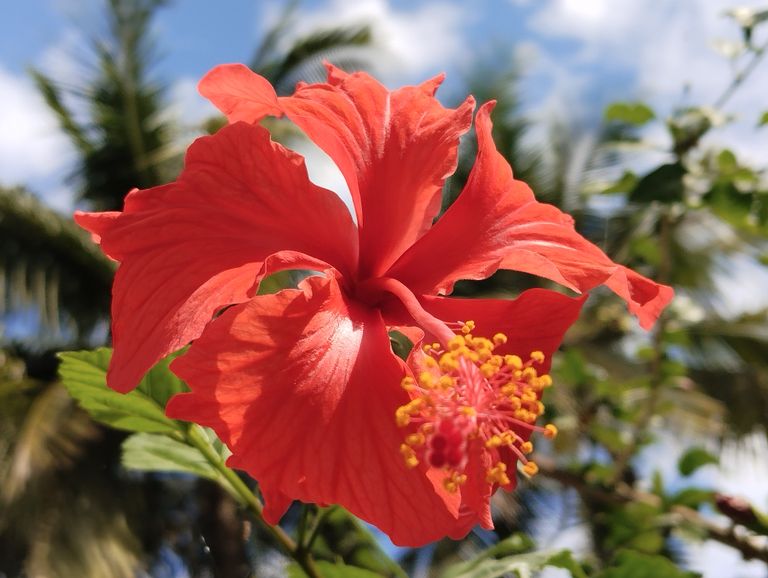
Hibiscus Plant Characteristics and Benefits.
The Hibiscus plant, commonly known as the China Rose, is a flowering shrub widely admired for its striking beauty and versatile uses. Belonging to the Malvaceae family, this plant is scientifically named Hibiscus rosa-sinensis. It is cultivated worldwide in tropical and subtropical climates, making it a popular choice for gardens, landscaping, and even as an indoor ornamental plant.
In this blog, we will explore the characteristics, types, and benefits of the Hibiscus plant, which is known as "Jaba Phool" in Bengali.
- Physical Characteristics
The Hibiscus plant is an evergreen shrub or small tree that can grow up to 2–5 meters in height. Its vivid flowers and lush green foliage make it a standout in any setting. Below are its key physical traits:
a. Leaves
Hibiscus leaves are simple, ovate, and glossy green, with serrated edges.
They are arranged alternately on the stem, contributing to the plant's dense and attractive appearance.
b. Flowers
The flowers are large, trumpet-shaped, and come in a variety of colors, including red, yellow, pink, white, and orange.
A single Hibiscus flower typically has five petals, though some hybrid varieties may have more.
These flowers are hermaphroditic, containing both male (stamens) and female (carpels) reproductive parts.
c. Roots and Stems
The plant has a shallow root system, making it easy to grow in pots or small garden spaces.
The stems are woody at the base and tender at the top.
d. Lifespan
A Hibiscus flower usually lasts for a day or two, but the plant blooms prolifically throughout its flowering season, ensuring constant beauty.
- Varieties of Hibiscus
The Hibiscus genus comprises hundreds of species and hybrids. The most common types include:
a. Hibiscus rosa-sinensis (China Rose)
The most popular variety, known for its large, vibrant flowers and ornamental appeal.
b. Hibiscus sabdariffa (Roselle)
This species is famous for its edible calyces, which are used to make teas, jams, and beverages.
c. Hibiscus syriacus (Rose of Sharon)
A hardy variety that thrives in temperate climates, often used in hedges and landscapes.
d. Hibiscus moscheutos (Swamp Mallow)
This species features massive flowers and is often grown in wetlands or along water bodies.
- Cultivation Requirements
Hibiscus plants are relatively easy to grow, provided their basic needs are met.
a. Soil
Prefers well-drained, loamy soil with a slightly acidic to neutral pH (6.0–7.0).
Enriched soil with organic matter or compost promotes healthy growth.
b. Sunlight
Hibiscus plants thrive in full sunlight, requiring at least 6–8 hours of direct light daily.
Partial shade may reduce flowering intensity.
c. Watering
Regular watering is essential, especially during the growing season.
Overwatering should be avoided to prevent root rot.
d. Temperature and Humidity
Ideal temperature range: 20–35°C (68–95°F).
They prefer humid conditions and struggle in frost or extremely cold weather.
e. Pruning and Maintenance
Prune the plant regularly to encourage branching and remove dead or damaged parts.
Fertilize with a balanced NPK fertilizer every few weeks during the blooming season.
- Benefits of Hibiscus Plants
The Hibiscus plant is not just ornamental but also offers numerous health, culinary, and environmental benefits.
a. Medicinal Uses
Hibiscus tea, made from Hibiscus sabdariffa, is rich in antioxidants and vitamin C. It helps reduce high blood pressure and improve digestion.
Hibiscus extracts are used in traditional medicine to treat hair loss, skin conditions, and inflammation.
b. Culinary Applications
The flowers and calyces are used in drinks, desserts, and salads.
Roselle is a key ingredient in many herbal teas and syrups.
c. Environmental Benefits
The plant attracts pollinators like bees, butterflies, and hummingbirds, contributing to ecological balance.
Its dense foliage provides shade and reduces soil erosion.
d. Cultural Significance
Hibiscus flowers hold religious and cultural importance in many countries. In India, they are offered to deities like Goddess Kali and Lord Ganesha.
- Common Issues and Solutions
Like all plants, Hibiscus is susceptible to certain pests and diseases.
a. Pests
Common pests include aphids, whiteflies, and spider mites. Use neem oil or insecticidal soap to control infestations.
b. Diseases
Leaf spot, powdery mildew, and root rot are common fungal infections. Ensure proper drainage and airflow to prevent these issues.
c. Nutrient Deficiency
Yellowing leaves often indicate a lack of nutrients. Apply micronutrient-rich fertilizers or compost.
- How to Propagate Hibiscus
Propagation can be done through seeds, cuttings, or grafting. The most popular method is through stem cuttings:
- Cut a 6–8-inch section from a healthy stem.
- Remove the lower leaves and dip the cut end in rooting hormone.
- Plant it in a pot with well-draining soil and water lightly.
- Place the pot in a warm, bright location, and new roots should develop in 4–6 weeks.
Conclusion
The Hibiscus plant is a perfect blend of beauty and utility. Whether you’re a gardener, herbal enthusiast, or someone seeking natural remedies, this plant offers something for everyone. With proper care and attention, Hibiscus can thrive and become a stunning addition to any home or garden.
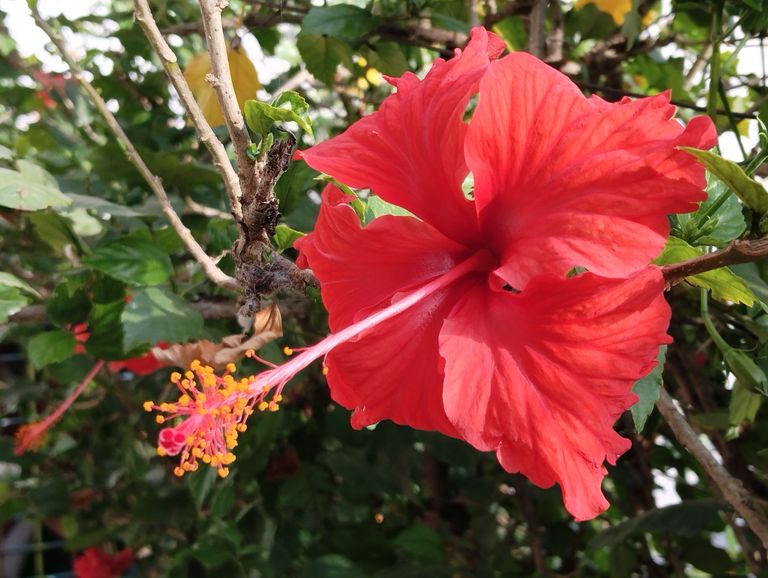
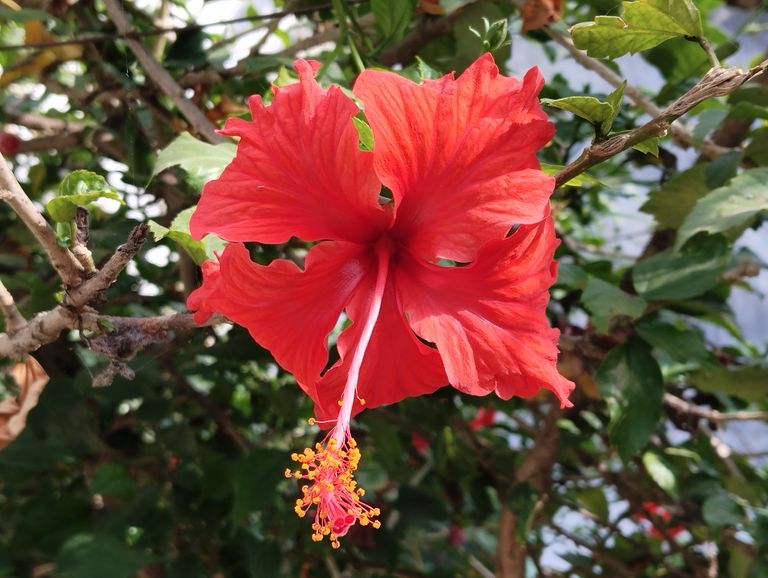
The Benefits of Hibiscus Petals
Hibiscus, also known as Hibiscus rosa-sinensis, is a flowering plant cherished for its vibrant blossoms and medicinal properties. The petals of the hibiscus flower, in particular, are packed with nutrients and have been used for centuries in various traditional remedies. This blog will explore the numerous health, beauty, and wellness benefits of hibiscus petals and how they can enhance your lifestyle.
- Rich in Nutrients and Antioxidants
Hibiscus petals are a powerhouse of vitamins such as Vitamin C, minerals like calcium, and bioactive compounds, including antioxidants. These components help combat free radicals, reducing oxidative stress and promoting overall health. Antioxidants in hibiscus petals play a key role in protecting the body from chronic diseases and premature aging.
- Supports Heart Health
Hibiscus petals are known for their ability to regulate blood pressure. Consuming hibiscus tea, made from dried petals, can lower high blood pressure, thanks to its diuretic properties and rich anthocyanins. Additionally, it helps maintain healthy cholesterol levels, reducing the risk of heart diseases.
- Boosts Immune System
The high Vitamin C content in hibiscus petals strengthens the immune system. Regular consumption of hibiscus-infused drinks or supplements can improve the body's resistance to infections, keeping you healthier year-round.
- Aids in Weight Management
Hibiscus tea is popular among those seeking to lose weight. It helps reduce the absorption of carbohydrates and fats, preventing weight gain. The tea also promotes metabolism, making it a natural and effective weight management tool.
- Enhances Skin Health
Hibiscus petals are often referred to as the “Botox plant” because of their anti-aging properties. The natural acids and antioxidants in hibiscus help exfoliate the skin, improve elasticity, and reduce wrinkles. Additionally, hibiscus extracts are used in face masks and serums to achieve a radiant and youthful complexion.
- Promotes Hair Growth
Hibiscus petals are widely used in hair care products for their ability to nourish the scalp, strengthen hair follicles, and promote growth. Applying a paste of hibiscus petals can reduce dandruff, prevent premature graying, and add shine to the hair.
- Supports Digestive Health
The natural enzymes in hibiscus petals improve digestion by promoting better bowel movements. Drinking hibiscus tea can relieve constipation and reduce symptoms of bloating and indigestion.
- Regulates Blood Sugar Levels
Hibiscus petals can help manage blood sugar levels, making them beneficial for individuals with diabetes. Regular consumption of hibiscus tea can improve insulin sensitivity and prevent sudden spikes in blood sugar.
- Improves Mood and Reduces Stress
Hibiscus petals contain natural compounds that have a calming effect on the nervous system. Drinking hibiscus tea can help reduce stress, anxiety, and even mild depression. Its natural aroma and flavor also provide a refreshing and uplifting experience.
- Acts as a Natural Detoxifier
Hibiscus petals aid in detoxifying the body by flushing out toxins. The diuretic properties of hibiscus tea promote kidney function and improve liver health, ensuring the body stays cleansed and rejuvenated.
How to Use Hibiscus Petals
- Hibiscus Tea: Dried petals can be steeped in hot water to make a refreshing and tangy tea.
- Face Masks: Mix hibiscus petal powder with yogurt or aloe vera for a hydrating face mask.
- Hair Treatments: Blend fresh petals with coconut oil to create a nourishing hair mask.
- Smoothies: Add dried or fresh petals to your smoothies for a health boost.
Precautions
While hibiscus petals are highly beneficial, excessive consumption can lead to side effects such as low blood pressure. Pregnant women and individuals on medication should consult a healthcare professional before incorporating hibiscus into their diet.
Conclusion
Hibiscus petals are more than just a vibrant addition to gardens; they are a treasure trove of health benefits. From improving heart health to enhancing beauty and promoting mental well-being, hibiscus petals can transform your health naturally. Start incorporating them into your daily routine and experience the wonders of this miraculous flower.
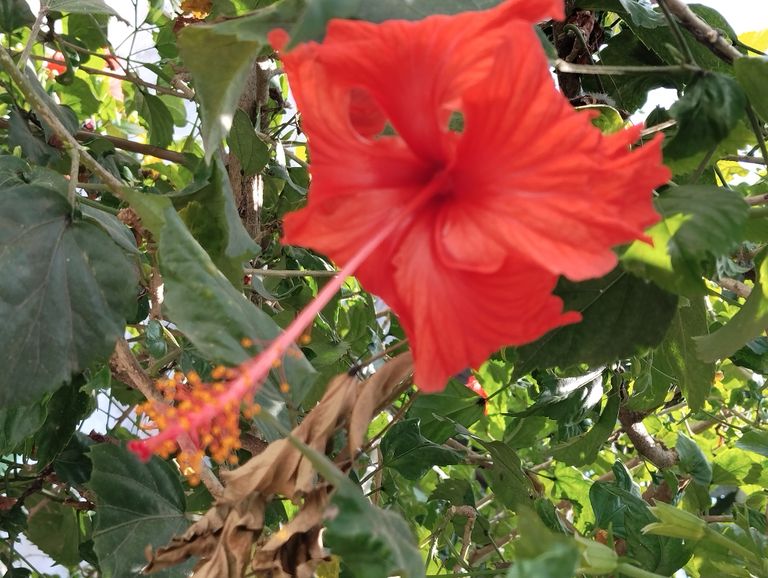
Hibiscus Tea: A Refreshing Elixir of Nature
Hibiscus tea, brewed from the vibrant petals of the hibiscus flower, is a fragrant and flavorful herbal infusion cherished across cultures for its health benefits and delightful taste. Known as "sour tea" in some regions, this ruby-red beverage is much more than a soothing drink—it's a powerhouse of wellness, tradition, and flavor.
In this blog, we’ll explore the origins, preparation, health benefits, and cultural significance of hibiscus tea.
The Origins of Hibiscus Tea
Hibiscus tea is derived from the sepals of the Hibiscus sabdariffa plant, native to tropical and subtropical regions worldwide. From Africa to Asia, hibiscus has played an integral role in both culinary and medicinal traditions.
- Africa: In Egypt and Sudan, hibiscus tea, locally known as karkadeh, is a traditional beverage served during celebrations and ceremonies. Ancient Egyptians prized hibiscus for its cooling properties, particularly in desert climates.
- Asia: In India and Southeast Asia, hibiscus is revered for its medicinal qualities, often used in Ayurvedic and traditional remedies.
- The Americas: In the Caribbean and Mexico, hibiscus tea is known as agua de jamaica, a refreshing drink blended with sugar and lime.
How to Prepare Hibiscus Tea
Preparing hibiscus tea is straightforward, and its versatility allows for numerous variations. Here's a basic recipe:
Ingredients:
1 cup dried hibiscus petals
4 cups water
Sweetener to taste (sugar, honey, or stevia)
Optional: lemon, ginger, or mint for added flavor
Instructions:
- Boil water: Heat 4 cups of water until it reaches a rolling boil.
- Steep the petals: Add the dried hibiscus petals to the boiling water. Reduce the heat and let them steep for 10–15 minutes.
- Strain: Use a fine mesh strainer to remove the petals.
- Sweeten and flavor: Add your preferred sweetener and additional flavors like lemon or ginger for an extra zing.
- Serve: Enjoy it hot or allow it to cool, then serve over ice for a refreshing iced tea.
Health Benefits of Hibiscus Tea
Hibiscus tea isn't just delicious; it's also packed with health benefits. Rich in antioxidants, vitamins, and minerals, it has been widely studied for its therapeutic properties.
- Heart Health:
Hibiscus tea is known to lower blood pressure. Studies show that its natural compounds help relax blood vessels, reducing hypertension.
It also aids in lowering LDL (bad cholesterol), promoting overall cardiovascular health.
- Rich in Antioxidants:
The tea is abundant in anthocyanins, which combat free radicals, reducing oxidative stress and inflammation.
- Weight Management:
Hibiscus tea helps regulate metabolism, making it a favorite among those looking to maintain or lose weight. It also has mild diuretic properties, helping to eliminate excess fluids.
- Boosts Immunity:
High in vitamin C, hibiscus tea fortifies the immune system and may reduce the duration of colds and flu.
- Improves Digestion:
Its natural enzymes and fiber content aid digestion, helping to alleviate bloating and constipation.
- Supports Liver Health:
Research suggests hibiscus may enhance liver function by detoxifying enzymes and reducing fat buildup.
Cultural Significance and Usage
Hibiscus tea holds a special place in many cultures, symbolizing warmth, hospitality, and health. In some regions, it is used as a ceremonial drink, while in others, it's a staple for quenching thirst in hot climates.
- Festivals and Weddings:
In Sudan and Egypt, karkadeh is a traditional wedding drink, symbolizing happiness and prosperity.
- Everyday Refreshment:
In Mexico and the Caribbean, agua de jamaica is a popular street drink, enjoyed as a cooling beverage on hot days.
- Medicinal Use:
In traditional medicine, hibiscus tea is prescribed for ailments ranging from colds to digestive issues.
Hibiscus Tea Variations
The beauty of hibiscus tea lies in its adaptability. Here are some creative twists:
- Iced Hibiscus Lemonade:
Combine iced hibiscus tea with fresh lemonade for a tangy, thirst-quenching drink.
- Spiced Hibiscus Chai:
Add spices like cinnamon, cloves, and ginger for a warm and aromatic twist.
- Hibiscus Mocktail:
Mix hibiscus tea with sparkling water, fresh mint, and a splash of orange juice for a festive, non-alcoholic beverage.
- Hibiscus Smoothie:
Blend chilled hibiscus tea with frozen berries and yogurt for a nutrient-rich smoothie.
Precautions and Side Effects
While hibiscus tea is generally safe, excessive consumption may cause side effects in some individuals:
Blood Pressure Concerns: Those with low blood pressure should consume it in moderation.
Pregnancy: Pregnant women are advised to consult a doctor before drinking hibiscus tea, as it may induce uterine contractions.
Allergies: Some people may experience allergic reactions; discontinue use if symptoms occur.
Conclusion
Hibiscus tea is a perfect blend of health, tradition, and taste. Whether you’re sipping it to cool off on a summer day or enjoying it warm during a chilly evening, this versatile beverage never fails to delight. With its myriad health benefits and cultural significance, hibiscus tea is a timeless treasure for tea lovers worldwide.
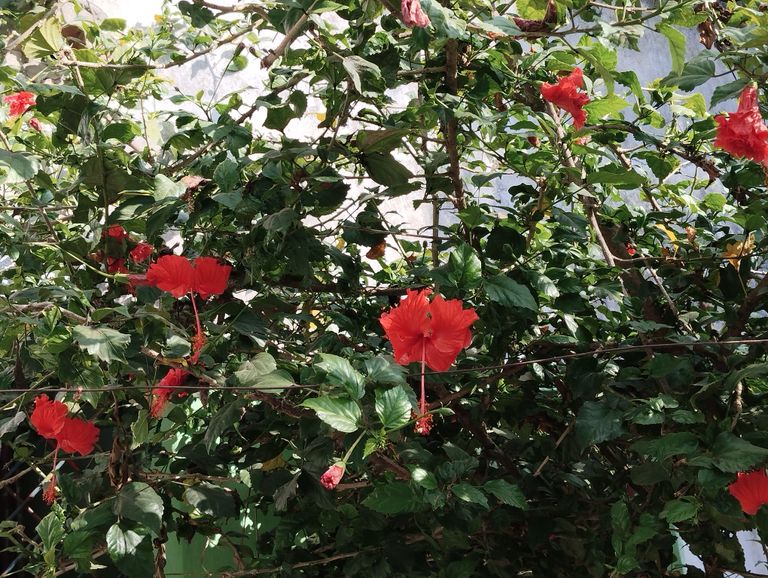
The Beauty of Hibiscus Flowers
Nature has gifted us an incredible variety of flora, each with its unique charm, but few can rival the vibrant beauty of the hibiscus flower. Known as "Jaba Ful" in Bengali, the hibiscus is a captivating bloom that enchants with its vivid colors, delicate petals, and cultural significance. From its ornamental appeal to its medicinal uses, the hibiscus is more than just a flower—it's a symbol of grace and life.
A Kaleidoscope of Colors
The hibiscus flower is renowned for its striking palette of colors. From the fiery red that exudes passion to the serene white symbolizing purity, the hibiscus blooms in shades of pink, yellow, orange, and even purple. These large, trumpet-shaped flowers with their velvety petals and prominent stamens are a feast for the eyes. Whether planted in gardens or placed in pots, hibiscus flowers have an unmatched ability to uplift any space.
Cultural and Spiritual Significance
The hibiscus holds a special place in various cultures and traditions. In Hinduism, red hibiscus flowers are often offered to the goddess Kali as a symbol of devotion and strength. The flower’s bold appearance and vibrant energy make it a fitting offering for powerful deities.
In many tropical regions, hibiscus flowers are used in leis, symbolizing hospitality and warmth. They are also a popular motif in art and fashion, representing beauty and femininity.
Medicinal and Herbal Uses
Beyond its beauty, the hibiscus flower is a treasure trove of health benefits. Hibiscus tea, made from the dried petals of the flower, is a popular beverage known for its tart flavor and vivid red color. Rich in antioxidants, it is celebrated for its ability to:
Lower blood pressure
Aid in weight loss
Boost liver health
Support heart health
In Ayurveda and traditional medicine, hibiscus is used to treat hair loss, improve skin health, and alleviate menstrual pain. Its extracts are often found in shampoos, oils, and face masks, enhancing its appeal as a natural remedy.
Ecological Importance
Hibiscus flowers are not just pleasing to humans—they are a vital resource for pollinators like bees, butterflies, and hummingbirds. Their bright colors and ample nectar make them a favorite in gardens, helping maintain ecological balance. Additionally, they thrive in warm climates and are relatively low-maintenance, making them a popular choice for gardeners.
Symbol of Beauty and Resilience
The hibiscus is more than just a flower; it’s a symbol of resilience. Despite its delicate appearance, the plant can withstand harsh tropical conditions, blossoming brightly even in challenging environments. This duality of fragility and strength makes the hibiscus a metaphor for life’s beauty and endurance.
Decorative Charm
The decorative appeal of hibiscus flowers cannot be overstated. They are a favorite in tropical-themed decor, weddings, and festivals. Their exotic beauty adds a touch of elegance to any setting. Whether floating in a bowl of water as a centerpiece or woven into garlands, hibiscus flowers never fail to impress.
Conclusion
The hibiscus flower, with its unmatched beauty and myriad benefits, is truly a wonder of nature. It captures our hearts with its vibrant hues, enriches our health with its medicinal properties, and inspires us with its resilience. A symbol of beauty, strength, and cultural heritage, the hibiscus continues to bloom as a testament to nature's incredible artistry.
Whether you admire it in a garden, sip it as tea, or offer it in devotion, the hibiscus flower stands as a timeless emblem of life's vibrant essence.
Congratulations, your post has been upvoted by @dsc-r2cornell, which is the curating account for @R2cornell's Discord Community.
Enhorabuena, su "post" ha sido "up-voted" por @dsc-r2cornell, que es la "cuenta curating" de la Comunidad de la Discordia de @R2cornell.